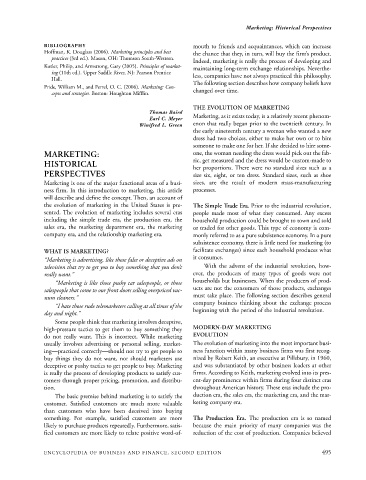Page 518 - Encyclopedia of Business and Finance
P. 518
eobf_M 7/5/06 3:15 PM Page 495
Marketing: Historical Perspectives
BIBLIOGRAPHY mouth to friends and acquaintances, which can increase
Hoffman, K. Douglass (2006). Marketing principles and best the chance that they, in turn, will buy the firm’s product.
practices (3rd ed.). Mason, OH: Thomson South-Western.
Indeed, marketing is really the process of developing and
Kotler, Philip, and Armstrong, Gary (2005). Principles of market- maintaining long-term exchange relationships. Neverthe-
ing (11th ed.). Upper Saddle River, NJ: Pearson Prentice less, companies have not always practiced this philosophy.
Hall.
The following section describes how company beliefs have
Pride, William M., and Ferrel, O. C. (2006). Marketing: Con-
cepts and strategies. Boston: Houghton Mifflin. changed over time.
THE EVOLUTION OF MARKETING
Thomas Baird
Earl C. Meyer Marketing, as it exists today, is a relatively recent phenom-
Winifred L. Green enon that really began prior to the twentieth century. In
the early nineteenth century a woman who wanted a new
dress had two choices, either to make her own or to hire
someone to make one for her. If she decided to hire some-
MARKETING: one, the woman needing the dress would pick out the fab-
ric, get measured and the dress would be custom-made to
HISTORICAL
her proportions. There were no standard sizes such as a
PERSPECTIVES size six, eight, or ten dress. Standard sizes, such as shoe
Marketing is one of the major functional areas of a busi- sizes, are the result of modern mass-manufacturing
ness firm. In this introduction to marketing, this article processes.
will describe and define the concept. Then, an account of
the evolution of marketing in the United States is pre- The Simple Trade Era. Prior to the industrial revolution,
sented. The evolution of marketing includes several eras people made most of what they consumed. Any excess
including the simple trade era, the production era, the household production could be brought to town and sold
sales era, the marketing department era, the marketing or traded for other goods. This type of economy is com-
company era, and the relationship marketing era. monly referred to as a pure subsistence economy. In a pure
subsistence economy, there is little need for marketing (to
WHAT IS MARKETING? facilitate exchanges) since each household produces what
“Marketing is advertising, like those false or deceptive ads on it consumes.
television that try to get you to buy something that you don’t With the advent of the industrial revolution, how-
really want.” ever, the producers of many types of goods were not
households but businesses. When the producers of prod-
“Marketing is like those pushy car salespeople, or those
ucts are not the consumers of those products, exchanges
salespeople that come to our front doors selling overpriced vac-
uum cleaners.” must take place. The following section describes general
company business thinking about the exchange process
“I hate those rude telemarketers calling at all times of the
beginning with the period of the industrial revolution.
day and night.”
Some people think that marketing involves deceptive,
high-pressure tactics to get them to buy something they MODERN-DAY MARKETING
do not really want. This is incorrect. While marketing EVOLUTION
usually involves advertising or personal selling, market- The evolution of marketing into the most important busi-
ing—practiced correctly—should not try to get people to ness function within many business firms was first recog-
buy things they do not want, nor should marketers use nized by Robert Keith, an executive at Pillsbury, in 1960,
deceptive or pushy tactics to get people to buy. Marketing and was substantiated by other business leaders at other
is really the process of developing products to satisfy cus- firms. According to Keith, marketing evolved into its pres-
tomers through proper pricing, promotion, and distribu- ent-day prominence within firms during four distinct eras
tion. throughout American history. These eras include the pro-
The basic premise behind marketing is to satisfy the duction era, the sales era, the marketing era, and the mar-
customer. Satisfied customers are much more valuable keting company era.
than customers who have been deceived into buying
something. For example, satisfied customers are more The Production Era. The production era is so named
likely to purchase products repeatedly. Furthermore, satis- because the main priority of many companies was the
fied customers are more likely to relate positive word-of- reduction of the cost of production. Companies believed
ENCYCLOPEDIA OF BUSINESS AND FINANCE, SECOND EDITION 495

